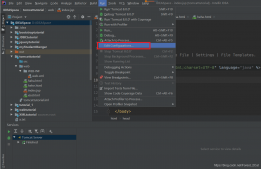本文通過是動態(tài)代理實現(xiàn)的AOP功能的封裝與配置的小框架.加深對動態(tài)代理和AOP編程的理解
設(shè)計
根據(jù)配置文件的鍵xxx對應(yīng)的值(類全名)創(chuàng)建相應(yīng)類的對象。
當(dāng)且僅當(dāng)xxx對應(yīng)的值為com.iot.proxy.aopframework.ProxyFactoryBean時,則生成相應(yīng)的動態(tài)代理類對象。代理對象的目標(biāo)類和通知實現(xiàn)類分別由xxx.target和xxx.advice配置
配置文件
config.propertiest位于aopframework包下
- xxx代表要加載的類
- xxx.advice代表通知接口的某個實現(xiàn)類
- xxx.target代表委托類
#xxx=java.util.ArrayList
xxx=com.iot.proxy.aopframework.ProxyFactoryBean
xxx.advice=com.iot.proxy.MyAdvice
xxx.target=java.util.ArrayList
包:com.iot.proxy.aopframework,有如下幾個類/接口:
- BeanFactory,用于讀取配置文件,根據(jù)配置創(chuàng)建相應(yīng)的對象
- ProxyFactoryBean,用于生成代理對象,含有兩個私有屬性:目標(biāo)和通知
- Advice,通知接口,用于把切面的代碼以對象的形式傳遞給InvocationHandler的的invoke方法
- MyAdvice,Advice接口的一個實現(xiàn)類,打印執(zhí)行方法前的時間及執(zhí)行耗時
- AopFrameWorkTest,測試效果
代碼
Advice接口
|
1
2
3
4
5
6
7
8
9
10
|
package com.iot.proxy.aopframework;import java.lang.reflect.Method;/** * Created by brian on 2016/2/2. */public interface Advice { void beforeMethod(Method method); void aftereMethod(Method method);} |
MyAdvice類
|
1
2
3
4
5
6
7
8
9
10
11
12
13
14
15
16
17
18
|
package com.iot.proxy.aopframework;import java.lang.reflect.Method;/** * Created by brian on 2016/2/2. */public class MyAdvice implements Advice{ long beginTime = 0 ; @Override public void beforeMethod(Method method) { System.out.println(method.getName()+" before at "+beginTime); beginTime = System.currentTimeMillis(); } @Override public void aftereMethod(Method method) { long endTime = System.currentTimeMillis(); System.out.println(method.getName()+" cost total "+ (endTime-beginTime)); }} |
BeanFactory類
|
1
2
3
4
5
6
7
8
9
10
11
12
13
14
15
16
17
18
19
20
21
22
23
24
25
26
27
28
29
30
31
32
33
34
35
36
37
38
39
40
41
42
43
44
45
46
47
48
49
50
51
52
53
54
55
56
57
58
|
package com.iot.proxy.aopframework;import java.io.IOException;import java.io.InputStream;import java.util.Properties;/** * Created by brian on 2016/2/2. */public class BeanFactory { Properties properties = new Properties(); public BeanFactory(InputStream inputStream){ try { properties.load(inputStream); } catch (IOException e) { e.printStackTrace(); } } public Object getBean(String name){ String className = properties.getProperty(name); Object bean = null; try { Class clazz = Class.forName(className); bean = clazz.newInstance(); } catch (ClassNotFoundException e) { e.printStackTrace(); } catch (InstantiationException e) { e.printStackTrace(); } catch (IllegalAccessException e) { e.printStackTrace(); } if (bean instanceof ProxyFactoryBean){ ProxyFactoryBean proxyFactoryBean = (ProxyFactoryBean)bean; Advice advice = null; Object target = null; try { advice = (Advice) Class.forName(properties.getProperty(name+".advice")).newInstance(); target = Class.forName(properties.getProperty(name+".target")).newInstance(); } catch (InstantiationException e) { e.printStackTrace(); } catch (IllegalAccessException e) { e.printStackTrace(); } catch (ClassNotFoundException e) { e.printStackTrace(); } proxyFactoryBean.setAdvice(advice); proxyFactoryBean.setTarget(target); Object proxy = ((ProxyFactoryBean) bean).getProxy(); return proxy; } return bean; }} |
ProxyFactoryBean類
|
1
2
3
4
5
6
7
8
9
10
11
12
13
14
15
16
17
18
19
20
21
22
23
24
25
26
27
28
29
30
31
32
33
34
35
36
37
38
39
|
package com.iot.proxy.aopframework;import java.lang.reflect.InvocationHandler;import java.lang.reflect.Method;import java.lang.reflect.Proxy;/** * Created by brian on 2016/2/3. */public class ProxyFactoryBean { private Object target; private Advice advice; public Object getProxy(){ Object proxy = Proxy.newProxyInstance( target.getClass().getClassLoader(), target.getClass().getInterfaces(), new InvocationHandler() { @Override public Object invoke(Object proxy, Method method, Object[] args) throws Throwable { advice.beforeMethod(method); Object retVal = method.invoke(target,args); advice.aftereMethod(method); return retVal; } } ); return proxy; } public Object getTarget() { return target; } public void setTarget(Object target) { this.target = target; } public Advice getAdvice() { return advice; } public void setAdvice(Advice advice) { this.advice = advice; }} |
AopFrameWorkTest類
|
1
2
3
4
5
6
7
8
9
10
11
12
13
14
|
package com.iot.proxy.aopframework;import java.io.InputStream;import java.util.Collection;/** * Created by brian on 2016/2/3. */public class AopFrameWorkTest { public static void main(String[] args) { InputStream inputStream = AopFrameWorkTest.class.getResourceAsStream("config.properties"); Object bean = new BeanFactory(inputStream).getBean("xxx"); System.out.println(bean.getClass().getName()); ((Collection) bean).clear(); }} |
輸出
- 配置xxx=com.iot.proxy.aopframework.ProxyFactoryBean
輸出為:
com.sun.proxy.$Proxy0
clear before at 0
clear cost total 0
- 配置xxx=java.util.ArrayList
輸出為:
java.util.ArrayList
可以看出,只改變配置文件,就可改變代碼的運行結(jié)果,從而達(dá)到靈活的效果
總結(jié)
以上就是本文關(guān)于Java實現(xiàn)AOP功能的封裝與配置的小框架實例代碼的全部內(nèi)容,希望對大家有所幫助。感興趣的朋友可以繼續(xù)參閱本站其他相關(guān)專題,如有不足之處,歡迎留言指出。感謝朋友們對本站的支持!
原文鏈接:http://blog.csdn.net/h3243212/article/details/50659231













